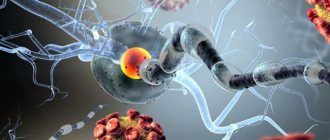There are many causes for hypocalcemia and hyperphosphatemia. But secondary hyperparathyroidism, which develops in patients receiving renal replacement therapy, deserves special attention. A progressive decrease in the number of functioning nephrons in chronic renal failure causes disruption of all links in the regulation of phosphorus-calcium metabolism.
When hyperphosphatemia occurs, there is a response decrease in ionized calcium. Hyperphosphatemia and hypocalcemia directly stimulate the synthesis of parathyroid hormone (PTH) by the parathyroid glands. Calcium affects the processes of PTH synthesis through calcium receptors present in the parathyroid glands, the number and sensitivity of which decrease. As the decline in renal function progresses, a deficiency of calcitriol, the active metabolite of vitamin D3 synthesized in the kidneys, also occurs, and the number of calcitriol receptors in the parathyroid glands decreases. As a result of these processes, the inhibitory effect of calcitriol on the synthesis and secretion of PTH is weakened, and skeletal resistance to the calcemic effect occurs, which is also accompanied by hypersecretion of PTH.
Causes and symptoms of secondary hyperparathyroidism
Secondary hyperparathyroidism differs from primary hyperparathyroidism in that it is not a direct consequence of changes occurring directly in the parathyroid glands. The main causes of development are pathological processes in other organs and systems of the body.
The appearance of secondary hyperparathyroidism can be caused by:
- renal pathologies: chronic renal failure (hereinafter chronic renal failure), tubulopathy, renal rickets;
- intestinal pathologies: malabsorption syndrome, Crohn's disease;
- bone pathologies: osteomalacia, Paget's disease;
- lack of vitamin D, various liver diseases, hereditary fermentopathy;
- malignant diseases including myeloma.
As a rule, secondary hyperparathyroidism develops as a result of various renal pathologies, in particular chronic renal failure, and the clinical picture is dominated by the symptoms of this particular disease. Characteristic symptoms:
- arthralgia, bone pain,
- weakness in the proximal muscles,
- spontaneously occurring fractures are possible,
- softening of bones and their curvature,
- various skeletal deformities.
Often, patients may develop extraosseous calcifications; this process can acquire a variety of clinical signs. The result of arterial calcification can be the appearance of ischemic changes. Periarticular calcifications form on the arms and legs. The process of calcification of the cornea with the conjunctiva, as well as recurrent conjunctivitis, causes red eye syndrome.
Under the influence of a large amount of PTH, a complex of complications develops, which is characteristic of secondary hyperparathyroidism:
- Renal osteopathies, the manifestations of which are skeletal deformation, bone pain, pathological fractures.
- Extraskeletal calcification, primarily damage to the valves and blood vessels of the heart.
- Itching.
- Spontaneous tendon rupture.
- Calciphylaxis.
Observation and forecast
The prognosis of such patients is determined by the success of correction of hyperparathyroidism. To date, there are no reliable data on long-term outcomes in such patients, but there is limited data indicating a high likelihood of regression of brown tumors after surgical treatment of primary hyperparathyroidism. For patients with secondary hyperparathyroidism due to CKD, the prognosis is also determined by the course of the underlying disease, and the treatment of brown tumors appears to be limited to drug treatment or kidney transplantation.
After hemiparathyroidectomy, as well as during drug treatment (zincalcet, zoledronic acid, vitamin D preparations), a dynamic assessment of laboratory parameters reflecting bone metabolism, in particular, PTH, blood calcium (total and ionized), alkaline phosphatase, phosphates is necessary. An acceptable method for assessing the therapeutic effect of hemiparathyroidectomy is PET/CT in the proven absence of a primary tumor, which can be a source of bone metastases, and subject to a PET/CT study before treatment.
It is noteworthy that the incidence of brown tumors has been decreasing over the past decades due to improved diagnostic methods and timely detection of hyperparathyroidism in patients. The extremely rare occurrence of brown tumors in the general population makes it difficult to create clear guidelines for the management of such patients, and in each specific case we are the subjects of a unique experiment with a limited amount of known data and treatment options. Nevertheless, in such conditions, the need for prevention and timely correction of hyperparathyroidism is obvious as the only possible method of combating brown tumors.
Bibliography:
- Philip Brabyn et al. HYPERPARATHYROIDISM DIAGNOSED DUE TO BROWN TUMORS OF THE JAW: A CASE REPORT AND LITERATURE REVIEW. Journal of Oral and Maxillofacial Surgery, 2021 DOI: 10.1016/j.joms.2017.03.013
- Modern ideas about the action of thyroid hormones and thyroid-stimulating hormone on bone tissue / Zh. E. Belaya, L. Ya. Rozhinskaya, G. A. Melnichenko. Problems of endocrinology, Vol. 52, No. 2 (2006). https://doi.org/10.14341/probl200652248-54
- Manolagas S. S // Endocr. Rev. - 2000. - Vol. 21. — P. 115-137
- 引用本文:方义杰, 洪国斌, 卢慧芳, 等. 棕色瘤的临床病理特征及影像学表现(Clinicopathological features and imaging manifestations of brown tumors) [J]. 中华医学杂志,2015,95 (45): 3691- DOI: 10.3760/cma.j.issn.0376-2491.2015.45.012
- Queiroz, IV, Queiroz, SP, Medeiros, R. et al. Brown tumor of secondary hyperparathyroidism: surgical approach and clinical outcome. Oral Maxillofac Surg 20, 435–439 (2016). https://doi.org/10.1007/s10006-016-0575-0
- Endocrine pathology / M. Kettyle William, A. Arky Ronald, p.145 – 151, 2016
- Levine MR, Chu A, Abdul-Karim FW. Brown Tumor and Secondary Hyperparathyroidism. Arch Ophthalmol. 1991;109(6):847–849. doi:10.1001/archopht.1991.01080060111036
- Santini-Araujo et al. (eds.), Tumors and Tumor-Like Lesions of Bone: For Surgical Pathologists, 815 Orthopedic Surgeons and Radiologists, DOI 10.1007/978-1-4471-6578-1_59, © Springer-Verlag London 2015
- Surgical approach and clinical outcome of a deforming brown tumor at the maxilla in a patient with secondary hyperparathyroidism due to chronic renal failure. Arquivos Brasileiros de Endocrinologia & Metabologia On-line version ISSN 1677-9487 Arq Bras Endocrinol Metab vol.50 no.5 São Paulo Oct. 2006 https://doi.org/10.1590/S0004-27302006000500021
- Nicola Di Daniele, Stefano Condò, Michele Ferrannini, Marta Bertoli, Valentina Rovella, Laura Di Renzo, Antonino De Lorenzo, “Brown Tumor in a Patient with Secondary Hyperparathyroidism Resistant to Medical Therapy: Case Report on Successful Treatment after Subtotal Parathyroidectomy,” International Journal of Endocrinology, vol. 2009, Article ID 827652, 3 pages, 2009. https://doi.org/10.1155/2009/827652
- W. J. Marshall. Clinical biochemistry, 6th edition p. 239 – 255
- HELL. Taganovich et al. Pathological biochemistry, pp. 282 – 316, 2015
- Sager, Sait et al. “Positron emission tomography/computed tomography imaging of brown tumors mimicking multiple skeletal metastases in patient with primary hyperparathyroidism.” Indian journal of endocrinology and metabolism vol. 16.5 (2012): 850-2. doi:10.4103/2230-8210.100682
- Jaime Alonso Reséndiz‐Colosia et all, Evolution of maxillofacial brown tumors after parathyroidectomy in primary hyperparathyroidism. J.of the sciences and specialties of the head and neck, vol. 30, issue 11, pages 1497 – 1503, 2016
- Highly Aggressive Brown Tumor in the Jaw Associated with Tertiary Hyperparathyroidism. Authors: Pinto, Lecio Pitombeira; Cherubinim, Karen; Salum, Fernanda Gonçalves; Yurgel, Liliane Soares; De Figueiredo, Maria Antonia Zancanaro. Source: Pediatric Dentistry, Volume 28, Number 6, November/December 2006, pp. 543-546(4)
- Tatiana Clementino Pinto Toscano de França et all. Bisphosphonates can reduce bone hunger after parathyroidectomy in patients with primary hyperparathyroidism and osteitis fibrosa cystica. Revista Brasileira de Reumatologia. Print version ISSN 0482-5004 Rev. Bras. Reumatol. vol.51 no.2 São Paulo Mar./Apr. 2011 https://doi.org/10.1590/S0482-50042011000200003
- L Darryl Quarles et al. Management of secondary hyperparathyroidism in adult dialysis patients, UpToDate, Mar 15, 2021
- Effect of alfacalcidol on the natural course of renal bone disease in mild to moderate renal failure. Hamdy NA, Kanis JA, Beneton MN, Brown CB, Juttmann JR, Jordans JG, Josse S, Meyrier A, Lins RL, Fairey IT BMJ. 1995;310(6976):358.
- Bisphosphonate pathway, and the genes are involved in the effects of bisphosphonates on osteoclasts. © PharmGKB. Reproduced with permission from PharmGKB and Stanford University. Gong Li, Altman Russ B, Klein Te. Bisphosphonates pathway. Pharmacogenetics and genomics (2009)
- Structure-Activity Relationships for Inhibition of Farnesyl Diphosphate Synthase in Vitro and Inhibition of Bone Resorption in Vivo by Nitrogen-Containing Bisphosphonates. James E. Dunford, Keith Thompson, Fraser P. Coxon, Steven P. Luckman, Frederick M. Hahn, C. Dale Poulter, Frank H. Ebetino and Michael J. Rogers. Journal of Pharmacology and Experimental Therapeutics February 2001, 296 (2) 235-242;
- Wetmore, James B et al. “A Randomized Trial of Cinacalcet versus Vitamin D Analogues as Monotherapy in Secondary Hyperparathyroidism (PARADIGM).” Clinical journal of the American Society of Nephrology: CJASN vol. 10.6 (2015): 1031-40. doi:10.2215/CJN.07050714
- Wang, G., Liu, H., Wang, C. et al. Cinacalcet versus Placebo for secondary hyperparathyroidism in chronic kidney disease patients: a meta-analysis of randomized controlled trials and trial sequential analysis. Sci Rep 8, 3111 (2018). https://doi.org/10.1038/s41598-018-21397-8
- Zekri, Jamal et al. “The anti-tumour effects of zoledronic acid.” Journal of bone oncology vol. 3.1 25-35. 15 Jan. 2014, doi:10.1016/j.jbo.2013.12.001
- Internet – Web Pathology portal. Created by: Dharam Rammani, MD https://www.webpathology.com/case.asp?case=663
Methods for diagnosing secondary hyperparathyroidism
To diagnose secondary hyperparathyroidism and its complications, a number of laboratory and instrumental research methods are required. Diagnosis can be carried out by specialists in various fields of medicine. This is explained by the wide variety of clinical manifestations of the disease. The disease is diagnosed using:
- anamnestic information (questioning, detailed study of the medical record, examination),
- analysis of characteristic symptoms,
- X-ray examinations of the bones of the arms, legs, skull and spine,
- studying the results of general, biochemical and specific blood tests for the concentration of parathyroid hormone, calcium, phosphorus,
- urine analysis,
- Ultrasound of the thyroid gland,
- studies of the composition of gastric juice,
- fibrogastroduodenoscopy (gastric walls and duodenum).
Of the laboratory data, the most important are the following studies:
- PTH concentrations,
- levels of ionized calcium, inorganic phosphorus,
- markers of bone resorption in the patient's blood serum.
Bone changes and extraskeletal calcification are assessed using densitometry, parathyroid scintigraphy, echocardiography, and MRI.
In the case of secondary hyperparathyroidism, it is very important to conduct a comprehensive diagnosis of the primary disease. The main directions of prevention and treatment of secondary hyperparathyroidism are the impact on all parts of the pathogenesis of the disease.
How does this happen?
As a result of prolonged and uncontrolled effects of PTH on osteoclasts, hyperplasia (an increase in the number of cells) and activation of the latter occurs. Due to the uncontrolled activation of osteoclasts, the same uncontrolled destruction of bone tissue and proliferation of connective tissue occurs. Often this process takes on a cystic-fibrous character: bone tissue is replaced by closed cavities, among which there is an accumulation of cells (osteoclasts, fibroblasts) and connective tissue fibers.
Nervous system
There is still debate about the effect of excess calcium levels in the blood on the function of the nervous system.
On the one hand, patients with hyperparathyroidism exhibit weakness, mood swings, and increased fatigue, which are significantly reduced after normalization of calcium and parathyroid hormone levels.
On the other hand, the symptoms are too nonspecific to be associated directly with parathyroid hormone.
The parathyroid glands themselves increase in size, and can often be noticed by an ultrasound doctor when examining the thyroid gland.
Forecast
In the absence of treatment and severe course of the disease, disability occurs. Life-threatening is hypercalcemic crisis , the mortality rate of which reaches 60%. Detection of the disease at an early stage and timely surgical treatment prevent the occurrence of osteovisceral complications.
After surgery, the symptoms of the disease disappear, recovery occurs in 90% of cases. During the first year after surgery, bone mineral density increases by 15-25%.
Causes of the disease
The reason for this is clinical manifestations: it hurts in places that have nothing to do with the parathyroid glands.
The parathyroid glands are located near the thyroid gland and there are usually four of them. They are responsible for calcium metabolism. The glands produce parathyroid hormone (parathyroid hormone, PTH), whose task is to supply calcium to the blood.
The work of the parathyroid glands is limited by vitamin D. With age, it is absorbed less and less well, therefore, control deteriorates. Having received complete freedom of action, the parathyroid gland begins to increase the level of calcium in the blood.
Who is at risk?
The following are at risk of developing hyperparathyroidism:
- persons with long-term and severe vitamin D or calcium deficiency;
- women during their menopause;
- persons taking lithium preparations;
- persons suffering from rare hereditary diseases in which the activity of part of the endocrine glands is disrupted;
- patients undergoing radiation therapy.
The following are at risk of developing hypoparathyroidism:
- persons whose close relatives suffer from this disease;
- persons who have undergone certain surgical interventions in the neck area, especially removal of the thyroid gland;
- persons suffering from autoimmune diseases (with such diseases, cells of the immune system begin to destroy the structures of their own body);
- patients undergoing radiation therapy.





